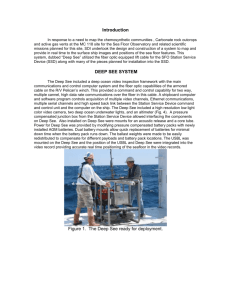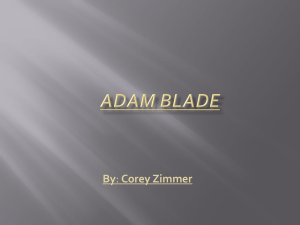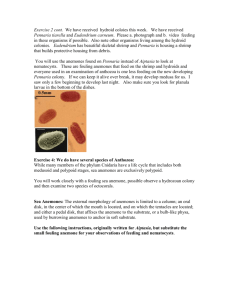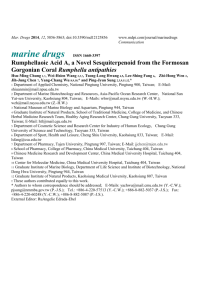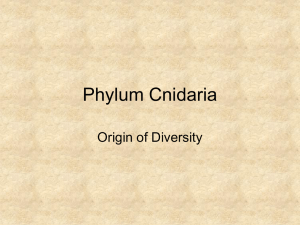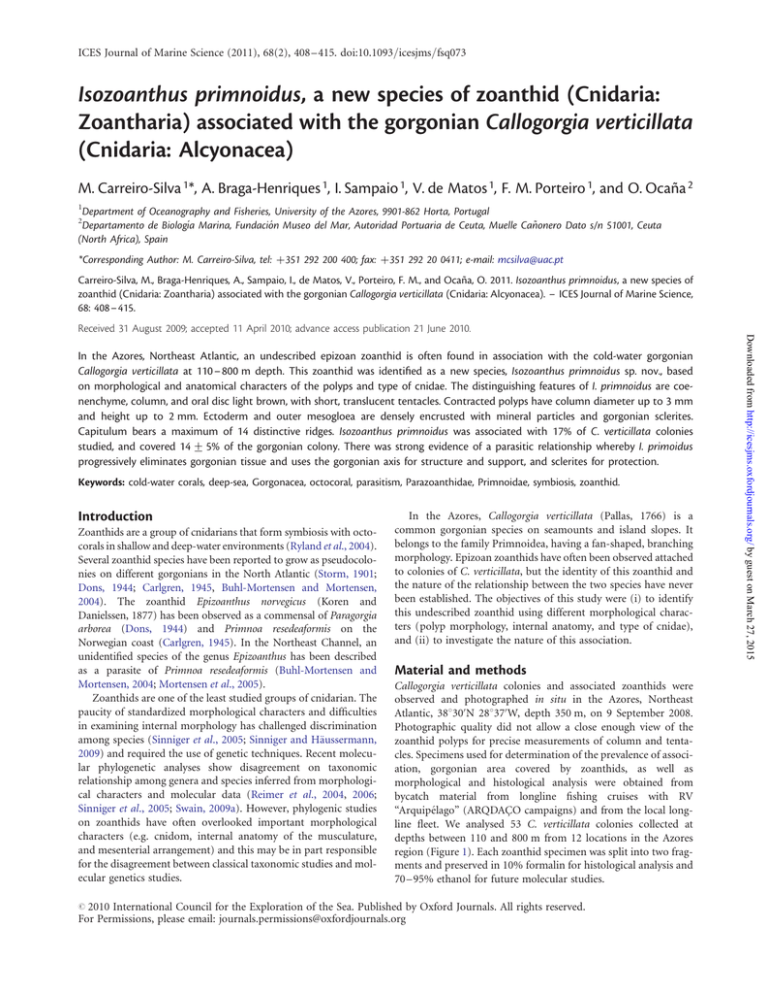
ICES Journal of Marine Science (2011), 68(2), 408 –415. doi:10.1093/icesjms/fsq073
Isozoanthus primnoidus, a new species of zoanthid (Cnidaria:
Zoantharia) associated with the gorgonian Callogorgia verticillata
(Cnidaria: Alcyonacea)
M. Carreiro-Silva 1*, A. Braga-Henriques 1, I. Sampaio 1, V. de Matos 1, F. M. Porteiro 1, and O. Ocaña 2
1
Department of Oceanography and Fisheries, University of the Azores, 9901-862 Horta, Portugal
Departamento de Biologı́a Marina, Fundación Museo del Mar, Autoridad Portuaria de Ceuta, Muelle Cañonero Dato s/n 51001, Ceuta
(North Africa), Spain
2
*Corresponding Author: M. Carreiro-Silva, tel: +351 292 200 400; fax: +351 292 20 0411; e-mail: mcsilva@uac.pt
Carreiro-Silva, M., Braga-Henriques, A., Sampaio, I., de Matos, V., Porteiro, F. M., and Ocaña, O. 2011. Isozoanthus primnoidus, a new species of
zoanthid (Cnidaria: Zoantharia) associated with the gorgonian Callogorgia verticillata (Cnidaria: Alcyonacea). – ICES Journal of Marine Science,
68: 408 –415.
In the Azores, Northeast Atlantic, an undescribed epizoan zoanthid is often found in association with the cold-water gorgonian
Callogorgia verticillata at 110 – 800 m depth. This zoanthid was identified as a new species, Isozoanthus primnoidus sp. nov., based
on morphological and anatomical characters of the polyps and type of cnidae. The distinguishing features of I. primnoidus are coenenchyme, column, and oral disc light brown, with short, translucent tentacles. Contracted polyps have column diameter up to 3 mm
and height up to 2 mm. Ectoderm and outer mesogloea are densely encrusted with mineral particles and gorgonian sclerites.
Capitulum bears a maximum of 14 distinctive ridges. Isozoanthus primnoidus was associated with 17% of C. verticillata colonies
studied, and covered 14 + 5% of the gorgonian colony. There was strong evidence of a parasitic relationship whereby I. primoidus
progressively eliminates gorgonian tissue and uses the gorgonian axis for structure and support, and sclerites for protection.
Keywords: cold-water corals, deep-sea, Gorgonacea, octocoral, parasitism, Parazoanthidae, Primnoidae, symbiosis, zoanthid.
Introduction
Zoanthids are a group of cnidarians that form symbiosis with octocorals in shallow and deep-water environments (Ryland et al., 2004).
Several zoanthid species have been reported to grow as pseudocolonies on different gorgonians in the North Atlantic (Storm, 1901;
Dons, 1944; Carlgren, 1945, Buhl-Mortensen and Mortensen,
2004). The zoanthid Epizoanthus norvegicus (Koren and
Danielssen, 1877) has been observed as a commensal of Paragorgia
arborea (Dons, 1944) and Primnoa resedeaformis on the
Norwegian coast (Carlgren, 1945). In the Northeast Channel, an
unidentified species of the genus Epizoanthus has been described
as a parasite of Primnoa resedeaformis (Buhl-Mortensen and
Mortensen, 2004; Mortensen et al., 2005).
Zoanthids are one of the least studied groups of cnidarian. The
paucity of standardized morphological characters and difficulties
in examining internal morphology has challenged discrimination
among species (Sinniger et al., 2005; Sinniger and Häussermann,
2009) and required the use of genetic techniques. Recent molecular phylogenetic analyses show disagreement on taxonomic
relationship among genera and species inferred from morphological characters and molecular data (Reimer et al., 2004, 2006;
Sinniger et al., 2005; Swain, 2009a). However, phylogenic studies
on zoanthids have often overlooked important morphological
characters (e.g. cnidom, internal anatomy of the musculature,
and mesenterial arrangement) and this may be in part responsible
for the disagreement between classical taxonomic studies and molecular genetics studies.
In the Azores, Callogorgia verticillata (Pallas, 1766) is a
common gorgonian species on seamounts and island slopes. It
belongs to the family Primnoidea, having a fan-shaped, branching
morphology. Epizoan zoanthids have often been observed attached
to colonies of C. verticillata, but the identity of this zoanthid and
the nature of the relationship between the two species have never
been established. The objectives of this study were (i) to identify
this undescribed zoanthid using different morphological characters (polyp morphology, internal anatomy, and type of cnidae),
and (ii) to investigate the nature of this association.
Material and methods
Callogorgia verticillata colonies and associated zoanthids were
observed and photographed in situ in the Azores, Northeast
Atlantic, 38830′ N 28837′ W, depth 350 m, on 9 September 2008.
Photographic quality did not allow a close enough view of the
zoanthid polyps for precise measurements of column and tentacles. Specimens used for determination of the prevalence of association, gorgonian area covered by zoanthids, as well as
morphological and histological analysis were obtained from
bycatch material from longline fishing cruises with RV
“Arquipélago” (ARQDAÇO campaigns) and from the local longline fleet. We analysed 53 C. verticillata colonies collected at
depths between 110 and 800 m from 12 locations in the Azores
region (Figure 1). Each zoanthid specimen was split into two fragments and preserved in 10% formalin for histological analysis and
70 –95% ethanol for future molecular studies.
# 2010 International Council for the Exploration of the Sea. Published by Oxford Journals. All rights reserved.
For Permissions, please email: journals.permissions@oxfordjournals.org
Downloaded from http://icesjms.oxfordjournals.org/ by guest on March 27, 2015
Received 31 August 2009; accepted 11 April 2010; advance access publication 21 June 2010.
409
A new species of zoanthid associated with Callogorgia verticillata
Morphological data were obtained from photographs and histological sections. Observations of zoanthid colonies were made using
a dissecting microscope Leica MZ 16FA, and measurements taken
using Image-J 1.40 software (US National Institutes of Health).
The tissue of the gorgonian host C. verticillata was also examined.
Observed sclerites within the zoanthid specimens were compared
with gorgonian sclerites after tissue removal using a sodium hypochlorite solution. Individual polyps dissected from zoanthid colonies were decalcified for 4 h with RDF Mild Decalcifier (CellPath
Ltd, UK) and desilicified for 2 h in 20% hydrofluoric acid, then
washed in distilled water. Polyps were dehydrated in ethanol,
cleared with xylene, embedded in paraffin, and sectioned. Serial
8-mm longitudinal and cross sections of polyps were stained with
Mallory Trichrome. Cross sections were cut transversely across the
column, at the level of the actinopharynx. Longitudinal sections
were cut across the marginal sphincter muscle.
Undischarged nematocysts were identified and measured in
squashed tissue preparations from the tentacles, column, pharynx,
and mesenterial filaments of three preserved specimens using light
microscopy (×1000, oil immersion). Cnidae were classified according to the terminology used by Ryland and Lancaster (2004).
Results
Zoanthid taxonomical description
Suborder Macrocnemina Haddon and Shackleton (1891)
Family Parazoanthidae Delage and Hérouard (1901)
Genus Isozoanthus Carlgren in Chun (1903)
Isozoanthus primnoidus new species.
Material examined
Holotype. Atlantic Ocean, Condor seamount, 38832′ N 29806′ W,
depth 293 m, 26 June 2008, associated with C. verticillata,
DOP-804. Paratypes. Atlantic Ocean, Condor seamount,
38808′ N 29805′ W, depths 274–293 m, 17 September 2006, associated with C. verticillata, DOP-3243; Atlantic Ocean, Açor Bank,
38817′ N 28852′ W, depth 368 m, 11 September 2007, associated
with C. verticillata, DOP-3051. Type specimens were deposited
in the reference collection of the Department of Oceanography
and Fisheries, University of the Azores.
Description
Colony morphology
Colonial zoanthid found at the surface of C. verticillata (Figure 2a).
In life, capitulum and oral disc light brown with short translucent
tentacles (Figure 2b). In preserved samples, polyps light brown
connected by thin coenenchyme growing over the gorgonian axis
(Figure 2c and d). Polyps occur at intervals of approximately 1–
1.5 polyp diameters, often in an orthogonal arrangement.
External anatomy
In preserved specimens, contracted polyps, 1.8 –3.0-mm diameter
and extending 1.0– 2.1 mm above the coenenchyme; proximal part
of the polyp slightly broader than distal part (Figure 3a). Ectoderm
and outer mesogloea densely encrusted with mineral particles, gorgonian sclerites, foramineferan tests, and sponge spicules, and
therefore appearing “flecked” with white (Figure 3a and b); sclerites were confirmed to be from C. verticillata (Figure 3b and c).
Downloaded from http://icesjms.oxfordjournals.org/ by guest on March 27, 2015
Figure 1. Geographic location of Callogorgia verticillata collection sites. Crosses indicate locations where the zoanthid Isozoanthus primnoidus
was found on C. verticillata; circles indicate locations where C. verticillata was found, but no I. primnoidus was present. The size of the circles is
proporcional to the number of colonies obtained in each location.
410
M. Carreiro-Silva et al.
Capitulum bearing 12 –14 distinct ridges. Thin cuticle present in
contact areas with the gorgonian.
Atlantic (Figure 1), with ocean temperatures ranging from 108C
to 158C.
Internal anatomy
Mesenteries in macrocnemic arrangement, but the state of retraction did not allow us to confirm the number. Musculature poorly
developed; retractor muscles not present in mesenteries; parietobasilar muscles are weak, forming very small pennons
(Figure 4a); stronger ectodermal musculature in tentacles
(Figure 4b). Sphincter is endodermal but short and concentrates
in the upper part of the column, forming a wide sinus
(Figure 4c); siphonoglyph conspicuous and prominent. Absence
of lacunae canals system and encircling sinus. Mesogloea of the
body wall presents a large number of lacunae left behind by dissolved mineral particles and host sclerites (Figure 4d). Lacunae
are less numerous and larger in the connected coenenchyme
(Figure 4e). Gonads associated with mesenterial filaments, with
ova and spermatozoids (Figure 4f). No zooxanthellae.
Cnidae
Cnidom spyrocists, basitrichs, holotrichs, microbasic bmastigophores, and microbasic p-mastigophores appear in
Figure 5. See Table 1 for sizes and distributions. Large holotrichs
(holotrich 1) were the most characteristic nematocyst observed in
this species, and were very common in the ectoderm of the body wall.
Ecology and distribution
Found on the surface of C. verticillata colonies at depths
between 110 and 800 m in the Azores region, Northeast
Etymology
Species named for type species association with a living gorgonian
of the family Primnoidea. The origin of the word primnoidae
comes from the Greek name Prymno, feminine, one of the
Oceanids, daughters of the Greek mythological god Oceanus,
used here as the masculine adjective, primnoidus, to agree with
the Latinized Isozoanthus, masculine, from the Greek anthos,
neuter, meaning flower.
Characterization of the association
Isozoanthus primnoidus was associated with 17% of C. verticillata
colonies studied (9 zoanthid-bearing colonies/53 total colonies),
and covered 14 + 5% (mean + s.d., n ¼ 6) of the gorgonian
colony. The largest concentration of zoanthid-bearing C. verticillata
occurred on Açor Bank and Princèsse Alice Bank.
The zoanthid coenenchyme often covered the central and secondary branches of colonies up to the finest pinnate branches
(Figure 2c). Gorgonian tissue was completely absent from most
areas covered by the zoanthid. However, on partially colonized
gorgonian branches, we observed “older” areas where gorgonian
tissue was absent (Figure 2d), and more recently colonized areas
where zoanthid polyps overgrew gorgonian polyps (Figure 3d).
Unusual agglomerations of gorgonian polyps along the axis were
observed next to areas overtaken by zoanthids (Figure 3e).
Downloaded from http://icesjms.oxfordjournals.org/ by guest on March 27, 2015
Figure 2. (a –d) Isozoanthus primnoidus (Z) on Callogorgia verticillata (G) colonies. (a) In situ photograph of living colonies; (b) close-up of
living I. primnoidus; (c) preserved colony of C. verticillata colonized by I. primnoidus; (d) close-up of preserved I. primnoidus on the gorgonian
axis.
A new species of zoanthid associated with Callogorgia verticillata
411
Downloaded from http://icesjms.oxfordjournals.org/ by guest on March 27, 2015
Figure 3. (a– h) Details on the association between Isozoanthus primnoidus (Z) and the gorgonian Callogorgia verticillata (G). (a)
Encrustations in I. primnoidus coenenchyme; (b) close-up of I. primnoidus coenenchyma showing C. verticillata sclerites (arrow); (c) sclerites of
C. verticillata for comparison with (b); (d) zoanthid polyp overgrowing gorgonian polyps; (e) atypical concentration of gorgonian polyps in the
area next to the zoanthid polyp; (f) anastomosis of gorgonian branches produced by I. primnoidus coenenchyma; (g) area of the gorgonian axis
without coenenchyma showing a zoanthid polyp; (h) juvenile I. primnoidus among C. verticillata polyps.
Discussion
Taxonomy
Based on histological analysis, this new zoanthid species was
placed in the family Parazoanthidae because of the position of
the sphincter muscle in the endoderm. In contrast, in the family
Epizoanthidae, the sphincter muscle is mesogloeal (Delage and
Hérouard, 1901).
Species of the family Parazoanthidae frequently form symbiotic
associations with other marine invertebrates (Sinniger and
Häussermann, 2009). Well-established species in the genus
412
M. Carreiro-Silva et al.
Parazoanthus are known to be associated with sponges (Swain and
Wulff, 2007). Another genus, Gerardia (Savalia), can be parasitic
on gorgonians, black corals, and even hydroids, and the damage
against the host is quite evident (see Ocaña and Brito, 2004).
Isozoanthus is an encrusting genus not generally considered as parasitic (Carlgren, 1913, 1927; Swain, 2009b).
In contrast to members of the genus Gerardia, the zoanthid
examined in this study does not secrete its own scleroproteinous
axis (see Ocaña et al., 2004, 2007). In addition, the lack of
lacunae canal systems and encircling sinus placed the studied
specimens in the genus Isozoanthus (members of the genus
Parazoanthus have these two morphological characters).
There are marked differences in morphological features and
cnidom characters between I. primnoidus and rocky or
shell-encrusting species belonging to the genus Isozoanthus
(described in Carlgren, 1913, 1927). The great dimensions of
the ectoderm nematocysts and the morphological structure
of the body wall distinguishes I. primnoidus from most species
of Isozoanthus. Other non-parasitic bathyal species have large
nematocysts in the body wall (e.g. I. multinsulosus Carlgren,
1913, I. ingolfi Carlgren, 1913, I. valdiviae Carlgren, 1924,
I. arenosus Carlgren, 1924, and I. africanus Carlgren, 1924) but
do not have the peculiar mesogloeal structure found in I. primnoidus. The zoanthid Isozoanthus antumbrosus Swain (2009b)
found in association with the hydroid Dentitheca dendritica is a
shallow-water species living in tropical Atlantic waters, but
with a polyp shape similar to that of I. primnoidus (Swain,
2009b). Despite differences in polyp dimensions, the two
species have a similar way of growing along the host and
similar polyp aggregations (see Swain, 2009b, Figure 1). The
internal anatomy indicates a stronger sphincter muscle in I.
primnoidus than in I. antumbrosus, but similar mesogloeal structure of the body wall.
Recent molecular analyses have shown a strong phylogenetic
conservatism in the evolution of host associations with symbiotic
zoanthids (Sinniger et al., 2005; Swain, 2009a), and substratum
specificity has been suggested as an additional taxonomic criterion (Sinniger et al., 2005; Reimer et al., 2008). Isozoanthus
Downloaded from http://icesjms.oxfordjournals.org/ by guest on March 27, 2015
Figure 4. (a– f) Histological sections of Isozoanthus primnoidus. (a) Mesenterial musculature (M) forming very small pennons (arrow); (b)
tentacles musculature (M); (c) endodermal sphincter muscle (SM) forming a wide sinus; (d) lacunae in the wall of the polyp (L); (e) lacunae in
the coenenchyme (L); (f) pharynx (P) and male gonads (S). Cross sections of contracted polyps are shown in (a), (b), (d), and longitudinal
sections in (c), (e), and (f). Scale bar ¼ 100 mm.
413
A new species of zoanthid associated with Callogorgia verticillata
Downloaded from http://icesjms.oxfordjournals.org/ by guest on March 27, 2015
Figure 5. Cnidae in the tentacles, column, pharynx, and mesenterial filaments of Isozoanthus primnoidus; letters correspond to cnidae listed in
Table 1.
primnoidus is not the first record of parasitic zoanthid on
primnoidae gorgonians. However, the zoanthid identified as
Epizoanthus sp., recorded on Primnoa resedaeformis (BuhlMortensen and Mortensen, 2004; Mortensen et al., 2005) displays
important shape and size differences from our material. Its
colour and larger size makes it closer to Epizoanthus norvegicus,
a well-known Primnoa- and Paragorgia-encrusting species.
Nevertheless, the species awaits detailed taxonomic study and
has some resemblance to the species Mesozoanthus fossii
(Sinniger and Häussermann, 2009) from Chile, which can grow
on dead Primnoella chilensis (see Sinniger and Häussermann,
2009), and Parazoanthus lucificum from California, which grows
on Muricea californica Aurivillius, 1931 (Cutress and Pequegnat,
1960). Future molecular analysis will help to clarify the
phylogenic relationship between the species described here and
other zoanthid species.
Symbiotic association
The term “symbiosis” is used here to refer to different organisms
living together (Saffo, 1992). The term “parasitism” is used to
describe a relationship where the symbiont benefits but the host
is harmed.
For I. primnoidus and its gorgonian hosts, several pieces of evidence indicate that the presence of the zoanthid causes harm to the
host. First, there is evidence that I. primnoidus can cover gorgonian
polyps and coenenchyma and change the position of gorgonian
polyps along the axis, resulting in the elimination of the gorgonian
tissue. Second, I. primnoidus incorporates gorgonian sclerites in its
414
M. Carreiro-Silva et al.
Table 1. Types, relative abundances, and sizes of cnidae of
Isozoanthus primnoidus.
Tissue
Tentacles
Column
Pharynx
Filament
Cnidae type
vc; spirocysts (A)
vc; basitrichs (B)
rc; p-mastigophore (C)
r; b-mastigophore (D)
vc; holotrich 1 (E)
r; p-mastigophore (F)
c; basitrich (G)
uc; holotrich 2 (H)
rc; p-mastigophore (I)
c; basitrich (J)
uc; holotrich 2 (K)
rc; b-mastigophore (L)
vc; p-mastigophore (M)
N
3/3
3/3
3/3
1/3
3/3
1/3
3/3
3/3
3/3
3/3
3/3
3/3
3/3
n
15
30
20
1
30
1
30
10
20
20
10
20
30
Size
15– 25 × 3 – 4
15– 18 × 3 – 4
16– 24 × 5 – 6
30 × 6
30– 40 × 15– 20
17 × 6
15– 17 × 3 – 4
9 –11 × 3 – 4
15– 20 × 5 – 6
13– 19 × 3 –3.5
9 –12 × 3 – 4
14– 20 × 6 – 7
15– 20 × 5 – 7
tissue. These observations suggest that I. primnoidus progressively
eliminates gorgonian tissue and uses the gorgonian axis for structure and support, and sclerites for protection. Reaching the
organic axis is the final colonization effect reported for other
zoanthids or actinarians associated with gorgonians, pennatularians, or antipatharians (Ocaña et al., 1995; Ocaña and Brito, 2004).
Isozoanthus primnoidus appears to expand and progressively
colonize the gorgonian branches by asexual colony multiplication.
We commonly observed the anastomosis (i.e. branch fusion) of
neighbouring gorgonian branches produced by the coenenchyma
of the zoanthid colony (Figure 3f), which suggests that this may
be a mechanism used by the zoanthid to progress the colonization
of the gorgonian.
Our observations do not allow us to determine the ingestion of
gorgonian tissue or the adsorption of substances from the host by
the zoanthid, but there is substantial evidence of harm done by the
zoanthid to the host. Therefore, we feel that parasitism best
describes this association. Further sample collection and aquarium
observations will help clarify the nature of this association.
A similar parasitic relationship between a zoanthid and a
deep-sea gorgonian has been described for Epizoanthus sp. and
the gorgonian P. resedeaformis in the Northern Channel
(Buhl-Mortensen and Mortensen, 2005; Mortensen et al., 2005).
Those authors observed Epizoanthus sp. gradually overgrowing
and killing P resedeaformis. Mortensen et al. (2005) suggested
that the degree of incidence of this zoanthid is related to gorgonian
damage by fishing, with Epizoanthus sp. colonizing tissue-abraded
areas and taking over large parts of the gorgonian skeleton. From
our data, we cannot determine whether a similar relationship
exists between gorgonian damage caused by fishing and the
degree of colonization by I. primnoidus. All C. verticillata specimens were collected within fishing grounds, so we have no comparison with areas outside fishing areas. We did observe
zoanthid polyps colonizing areas of the gorgonian axis with no
tissue (Figure 3g), possibly indicating that damaged gorgonian
branches may be more susceptible to colonization by zoanthids.
Nevertheless, we also observed a juvenile stage of I. primnoidus
between two clusters of C. verticillata polyps (Figure 3h),
Acknowledgements
This study was supported by the EU-funded CoralFISH project
(FP7-ENV-2007-1 213144), Fundação para a Ciência e a
Tecnologia (M. C-S, SFRH-BPD-34634 –2007) and Direcção
Regional para a Ciência e a Tecnologia (AB-H, M3.1.2/F/016/
2008). We thank bottom longline fishers. In particular Jorge
Gonçalves, and the chief scientists (Gui Menezes and Diana
Catarino) of ARQDAÇO campaigns for providing specimens.
We are also grateful to Department of Oceanography and
Fisheries technicians, Ricardo Medeiros for map elaboration and
Domitilia Rosa for her help with the histological techniques. The
Rebikoff-Niggeler Foundation is gratefully acknowledged for
permission to use their photographs.
References
Buhl-Mortensen, L., and Mortensen, P. B. 2004. Symbiosis in deepwater corals. Symbiosis, 37: 33– 61.
Buhl-Mortensen, L., and Mortensen, P. B. 2005. Distribution and
diversity of species associated with deep-sea gorgonian corals off
Atlantic Canada. In Cold-water Corals and Ecosystems, pp.
849– 879. Ed. by A. Freiwald, and J. M. Roberts. Springer, Berlin.
1244 pp.
Carlgren, O. 1913. Zoantharia. The Danish Ingolf Expedition, vol. 5,
part 4, pp. 1 – 65.
Carlgren, O. 1927. Actiniaria and Zoantharia. In Further Zoological
Results of the Swedish Antarctic Expedition 1901– 1903, under
the direction of Dr. Otto Nordenskjold, 2: 1 – 102.
Carlgren, O. 1945. Polypdyr (Coelenterata). III. Koraldyr. Danamarks
Fauna, 51 BD. Kobenhavn. 168 pp.
Chun, C. 1903. Aus den Tiefen des Weltmeeres. Schilderungen von der
Deutschen Tiefsee-Expedition. von Gustav Fisher, Jena. 592 pp.
Cutress, C. E., and Pequegnat, W. E. 1960. Three new species of
zoantharia from California. Pacific Science, 14: 89 – 100.
Delage, Y., and Hérouard, E. 1901. Traité de Zoologie Concrète, vol. II.
Les Coelentérés. Reinwald, Paris. 848 pp.
Dons, C. 1944. Norges korallrev. Det Kongelige Norske Videnskabers
Selskabs Forhandlinger, 16: 37 – 82.
Haddon, A. C., and Shackleton, A. M. 1891. A Revision of the British
Actiniæ. Part II: The Zoantheæ. Scientific Transactions of the Royal
Dublin Society, 4: 609 – 672.
Mortensen, P. B., Buhl-Mortensen, L., Gordon, D. C., Fader, G. B. J.,
McKeown, D. L., and Fenton, D. G. 2005. Effects of fisheries on
deepwater gorgonian corals in the Northeast Channel, Nova
Scotia. In Benthic Habitats and the Effects of Fishing,
pp. 369– 382. Ed. by B. W. Barnes, and J. P. Thomas. American
Fisheries Society Symposium, 41.
Ocaña, O., and Brito, A. 2004. A review of Gerardiidae (Anthozoa:
Zoantharia) from the Macaronesian Islands and the
Mediterranean Sea with the description of a new species. Revista
de la Academia Canaria de Ciencias, 3– 4: 159– 189.
Ocaña, O., Brito, A., González, G., and Herrera, R. 2007. Additions in
relation to Gerardiidae from the Macaronesian waters and the
Mediterranean Sea (Anthozoa: Zoantharia). Vieraea, 35: 163 – 168.
Ocaña, O., Brito, A., Núñez, J., and Bacallado, J. J. 1995. Redescripción
de Geradia savaglia (Bertoloni, 1819) (Anthozoa: Zoantharia:
Gerardiidae). Vieraea, 24: 153 – 164.
Downloaded from http://icesjms.oxfordjournals.org/ by guest on March 27, 2015
N, ratio of the number of individuals examined having a particular type of
cnidae to the total number examined; n, the number of measured capsules.
Measurements, in mm, are given as a range of length × width. Capital
letters refer to images in Figure 5. Lower-case letters indicate the relative
abundance: vc (very common); c (common); rc (rather common); uc
(uncommon); r (rare).
suggesting that they can also colonize areas of the colony that
are not damaged, probably by sexual reproduction. Future
studies comparing number of colonized C. verticillata colonies
inside and outside fishing areas will help to clarify the effect of fisheries on the degree of colonization by zoanthids.
A new species of zoanthid associated with Callogorgia verticillata
Sinniger, F., and Häussermann, V. 2009. Zoanthids (Cnidaria:
Hexacorallia: Zoantharia) from shallow waters of the southern
Chilean fjord region, with descriptions of a new genus and two
new species. Organisms Diversity and Evolution, 9: 23– 36.
Sinniger, F., Montoya-Burgos, J. L., Chevaldoné, P., and Pawlowski, J.
2005. Phylogeny of the order Zoantharia (Anthozoa, Hexacorallia)
based on mitochondrial ribosomal genes. Marine Biology, 147:
1121– 1128.
Storm, V. 1901. Oversigt over Throndheimsfjordens fauna (med et
kort). Trondhjems Biologiske Station, Meddelelser fra stationsanleggets arbeidskomite, H. Moe’s Bog and Accidentstrykkeri,
Trondhjem. 20 pp.
Swain, T. D. 2009a. Phylogeny-based species delimitations and the
evolution of host associations in symbiotic zoanthids (Anthozoa,
Zoanthidea) of the wider Caribbean region. Zoological Journal
of the Linnean Society, 156: 223 – 238.
Swain, T. D. 2009b. Isozoanthus antumbrosus, a new species of
zoanthid (Cnidaria: Anthozoa: Zoanthidea) symbiotic with
Hydrozoa from the Caribbean, with a key to hydroid and spongesymbiotic zoanthid species. Zootaxa, 2051: 41 – 48.
Swain, T. D., and Wulff, J. L. 2007. Diversity and specificity of
Caribbean sponge-zoanthid symbioses: a foundation for understanding the adaptive significance of symbioses and generating
hypotheses about higher-order systematics. Biological Journal of
the Linnean Society, 92: 695– 711.
Downloaded from http://icesjms.oxfordjournals.org/ by guest on March 27, 2015
Ocaña, O., den Hartog, J. C., and van Ofwegen, L. P. 2004. Ring sea
anemones, an overview (Cnidaria, Anthozoa, Actiniaria).
Graellsia, 60: 143 – 154.
Reimer, J. D., Nonaka, M., Sinniger, F., and Iwase, F. 2008.
Morphological and molecular characterization of a new genus
and new species of parazoanthid (Anthozoa: Hexacorallia:
Zoantharia) associated with Japanese red coral. Coral Reefs, 27:
935– 949.
Reimer, J. D., Ono, S., Fujiwara, Y., Takishita, K., and Tsukahara, J.
2004. Reconsidering Zoanthus spp. diversity: molecular evidence
of conspecificity within four previously presumed species.
Zoological Science, 21: 517– 525.
Reimer, J. D., Ono, S., Iwama, A., Takishita, K., Tsukahara, J., and
Maruyama, T. 2006. Morphological and molecular revision of
Zoanthus (Anthozoa: Hexacorallia) from southwestern Japan
with description of two new species. Zoological Science, 23:
261– 275.
Ryland, J. S., Brasseur, M. M., and Lancaster, J. E. 2004. Use of cnidae
in taxonomy: implications from a study of Acrozoanthus australiae
(Hexacorallia, Zoanthidea). Journal of Natural History, 38:
1193– 1223.
Ryland, J. S., and Lancaster, J. E. 2004. A review of zoanthid nematocyst types and their population structure. Hydrobiologia, 530/531:
179– 187.
Saffo, M. B. 1992. Coming to terms with a field: words and concepts in
symbiosis. Symbiosis, 14: 17 – 31.
415

